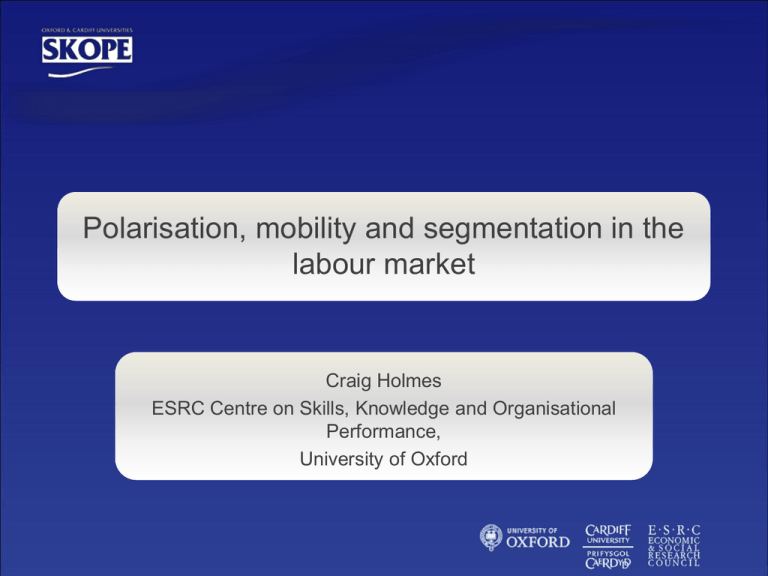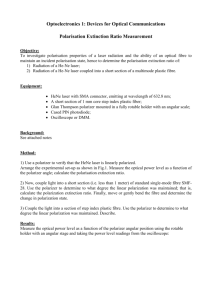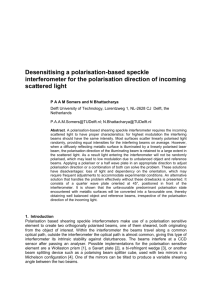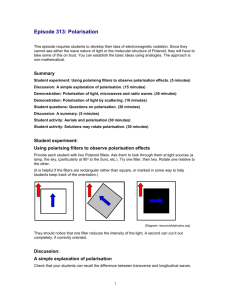Job polarisation in the UK: An assessment and implications for skills
advertisement

Polarisation, mobility and segmentation in the labour market Craig Holmes ESRC Centre on Skills, Knowledge and Organisational Performance, University of Oxford Labour market segmentation • Labour market segmentation theory developed as a departure from traditional models of labour supply and demand in the 1960s and 1970s • LMS suggests it is possible to identify parts of the labour market between which mobility is severely or entirely restricted – These restrictions are related to factors other than individual skills or abilities – Dual market: primary and secondary sector distinguished by wages, security, prospects for promotion and training investment – Initial employment matters workers becoming ‘trapped’ Labour market segmentation • The initial literature did not find significant empirical support. – Mayhew and Roswell (1976) looking at mobility between three labour market segments in the UK over the past working life of employees in 1972. – Segments were defined by occupation and status within their jobs. – Allocation of each occupation-status pair was based on the authors' own judgment, intention of creating segments of the lowest possible mobility. – Mobility matrices derived from this method show significant mobility between segments for many individuals. Job polarisation in the UK • Polarisation hypothesis (Goos and Manning 2007): – Price of computer capital has fallen since late 1970s – Computer capital replaces labour engaged in routine tasks – Non-routine tasks may be complementary to computer capital (e.g. management, skilled professionals) – Result: growth in non-routine occupations due to changes in demand (complementarities) and supply (displaced routine workers) – Routine occupations found in middle of income distribution – Non-routine occupations found at top and bottom of distribution • Managers, skilled professionals at the top • Non-routine ‘service’ occupations at the bottom e.g. hairdressers, cleaners Polarisation and segmentation • Obvious overlap between the primary and secondary segments and growth occupations • Individuals tend to move short distances within the labour market in terms of job quality. Declining middling occupations reduces options for transitory upward steps to better occupations. • Hence, a hollowed-out labour market could create two segments with limited mobility between them. The labour market and segmentation • Jobs defined by occupation, industry and skill: Industries Levels of skill or expertise within each industryoccupation Occupational groups increasing in quality The labour market and segmentation • Example 1: craft union model or occupational labour markets Industries Primary segment Occupational groups Secondary segment The labour market and segmentation • Example 2: internal labour markets Industries Primary segment Occupational groups Secondary segment The labour market and segmentation • Example 3: polarisation Industries Primary segment Middling occupations Secondary segment Occupational groups The labour market and segmentation • A hollowed-out labour market has – Fewer middle jobs for low wage workers to move into – Increasing competition for those that remain. – Significant upward mobility may either be slower, or require much more difficult and sizeable leaps. • Before embarking on a study of mobility using longitudinal analysis, it is important to understand the ways the polarisation phenomena has or has not manifested within a dataset that can be used for analysing working life mobility Job polarisation in the UK: an assessment • Holmes, (2010), SKOPE research paper No. 90 • Looks at single cohort from National Child Development Study between 1981 (aged 23) and 2004 (aged 46). • Replicates the Goos and Manning methodology for our NCDS dataset – Finds growth in high wage and low wage occupations, decline in mid-range occupations, proxied by 1981 wage – Evidence of routinisation driven employment changes Job polarisation in the UK: an assessment • However, wage distributions exhibit little evidence of polarisation – Most jobs still fall in the middle of wage distribution – How can these two observations be reconciled? • Existing evidence relies on a strong assumption that wage structures have remained constant over the past three decades – Changing wage structures, due to the associated changes in supply and demand of different workers, may have led to a new type of middling occupation Job polarisation in the UK: an assessment • Change in employment share of wage deciles. • Initially highest and lowest paid occupations grew more than the middle earning occupations Job polarisation in the UK: an assessment • Resulting wage distributions are important • Absent of other effects, a polarising labour force should be observed as in the diagram below cumulative probability 1 initial distribution polarising distribution 0 log wage Job polarisation in the UK: an assessment • Changing distributions from NCDS cohort (hourly and weekly, full-time workers): Job polarisation in the UK: an assessment • Econometric methods for analysing changes accurately • Descriptive method (see Holmes, 2010) – change in employment at each (log) wage percentile • Polarisation illustrative example: Job polarisation in the UK: an assessment Further research • This suggests polarisation may not be as clear-cut a mechanism for creating labour market segmentation • However, still suggests several issues for further mobility analysis – Destinations of displaced routine occupation workers • Are they able to move upwards? • Difference between occupational and wage mobility – Experience of new entrants compared to existing workers • Are new entrants more polarised? • Do they experience different patterns of occupational and wage mobility – Role of skills in both cases Further research • Destination of displaced routine workers – Model: four occupational categories (professional, managerial, routine and service) – Separate out transitions from routine occupations caused by routinisation from those caused by career advancement – Similarly for transitions between routine and service occupations – Empirical strategy: • Define four occupational categories (SOC, SEG) • Calculate transition probabilities in NCDS (1981 – 2004) • Apply to larger sample of 23 year olds in 1981 (e.g. LFS) and compare to a counterfactual occupational structure (e.g. 46 year olds in LFS 1981) Further research • Destination of displaced routine workers – Initial results: Initial structure, Pre-routinised Post-routinised 1981, 23 year structure, 46 year structure, 46 olds olds years olds Professional 8.4% 9.5% 13.2% Managerial 10.1% 12.6% 25.6% Routine 69.3% 66.6% 41.1% Service 12.2% 11.3% 20.1% • Probability of transition to professional depends on having a degree, rather than starting occupation • Need to breakdown upward movers by upskilled and non-upskilled Further research • Different experiences of later cohorts – Autor and Dorn (2009) – declining occupations are getting “older” – Continue using cohort approach - make use of later cohort study (1970 British Cohort Study) for comparison – Differences at entry – more polarised as older workers hold on to positions in declining occupations. New entrants driving cross sectional polarisation? – Different mobility opportunities compared to NCDS cohort?











